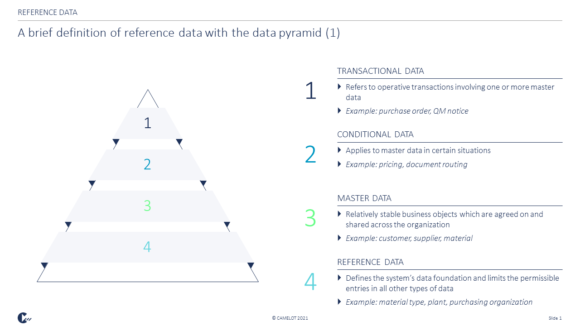Every organization strives for efficiently running operational processes which are enabled by governing the basic data types that form the foundation any (SAP) system. However, one of the most fundamental data types is mostly forgotten in this picture – reference data. To tackle this topic, Camelot ITLab has developed a new solution to govern reference data in a centralized system. Find out more about the Why’s and How’s in this blog.
Why You Should Care about Reference Data
In general, we can look at data as a hierarchical pyramid consisting of the different data types like transactional data, conditional data, master data and reference data.

As a basic definition, reference data forms the data foundation of any system and provides a structured approach to master data maintenance. This data is used to classify and categorize other data types. By utilizing this structured approach, the operational business processes can run efficiently and smoothly as they can rely on the quality of the data used.
Looking from an end-user’s perspective of a system, reference data is usually what they will find in a drop-down field or list of values.
Looking at reference data from the perspective of an SAP system it is nothing more and nothing less than customizing.
The Challenge of Keeping your Systems’ Data Foundation Clean
Depending on your system usage (may it be a system for master data maintenance of a system to do customer relationship management) a considerable amount of fields will be based on reference data, already highlighting its relevance and importance. Subsequently, reference data have an impact on the efficiency of business processes. Having a standardized set of high-quality reference data surely enables them to run more efficiently.
Keeping the data maintenance process in mind, it is also important to have these foundational data maintained only once in a centralized system and have them distributed across the entire system landscape. Imagine the introduction of a new purchasing group in the organization and having to maintain the same data in a multitude of systems, e.g., the operational S/4 HANA system or the CRM system, to make this set available for use in the P2P processes of these systems.
The same goes for the accountability of changes. As reference data can influence nearly all business processes, it is of high importance to create and change this data in a governed way. This means that the data changes must be approved via workflows, creating accountability for the changes. It also ensures the transparency and traceability of any data changes.
Camelot’s Take on Reference Data Maintenance: Reference Data Management with SAP MDG
Camelot’s Reference Data Management was developed and implemented by reusing the SAP Master Data Governance’s custom object framework. Therefore, the solution enables the maintenance of Reference Data by integration into already existing MDG governance concepts.
This makes the solution easily accessible to users that already work with MDG because the general principles are the same.
On the technical side, the solution integrates with SAP’s Transport Management as well. In that way, it is possible to create and change Reference Data in the governed RDM solution and distribute the approved data via existing transport routes of all connected systems, adhering to the SAP systems’ fundamentals.
|
Existing Approach |
Camelot‘s Solution |
|
Standardization |
|
| – Structure is not defined in the system and cannot be enforced – Maintain data with informal rules – no hard checks- Manual checks need to be performed |
– Enforcement of rules – therefore ensuring data quality and structure of data – Derivation rules reduce maintenance efforts and ensure correctness of data – Data fully standardized across system landscape |
|
Process Transparency |
|
| – No approval for new data sets – Wide range of user can apply changes- Each system / client is responsible for data maintenance – No orchestration across the system landscape |
– Automatically synchronized data throughout all the systems – Full traceability of changes via change documents – UI containing all relevant data point in one place – Transparent and comprehensible maintenance – Involvement of all relevant stakeholders |
|
Governance |
|
| – Each data set exists on their own – No control over changes – No entire traceability of changes |
– Customizable workflow with dynamic agent determination – Assignment of roles and authorizations to relevant parties – Automatic creation of transport in all target systems / replication via web service or RFC – Monitoring of replication and Transports |
Bringing the Future of Reference Data Management to You
Our solution Camelot Reference Data Management is available via the SAP Store.
If this piqued your interest, please feel free to contact Thomas Tolksdorf (tto@camelot-itlab.com) or Tobias Balogh (tbal@camelot-itlab.com) to learn more about our ideas and solutions regarding Reference Data Management.
We would like to thank Luis Morantes for his valuable contribution to this article.

